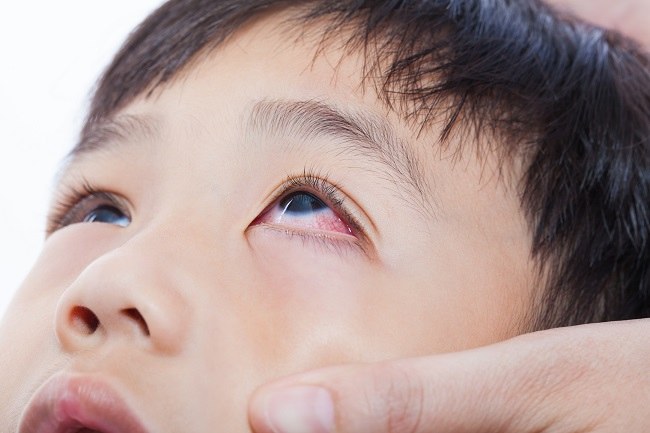Toxic epidermal necrolysis (TEN) is a hypersensitivity reaction of the skin which is generally triggered by the use of drugs. Toxic epidermal necrolysis can be characterized by: skin which blisters and peels, resembling a burn.
Toxic epidermal necrolysis is a rare condition and can lead to serious complications, such as severe infection, pneumonia, and sepsis. Therefore, toxic epidermal necrolysis needs to be treated immediately.

Toxic epidermal necrolysis is the same as Stevens-Johnson syndrome (SJS), which is a hypersensitivity reaction to the skin in the form of blisters. However, toxic epidermal necrolysis is a more severe version.
The most obvious difference between SJS and NET is the extent of the injury. In SJS, the wound area is no more than 10 percent of the body surface. Whereas in toxic epidermal necrolysis, the blisters are more widely spread, which is more than 30 percent of the body surface.
Causes of Toxic Epidermal Necrolysis
The exact cause of toxic epidermal necrolysis is unknown. However, it is known that NET is a type of hypersensitivity reaction. A hypersensitivity reaction is a condition when the body's immune system (immune system) erroneously or overreacts, causing unwanted effects.
Hypersensitivity reactions to toxic epidermal necrolysis are generally triggered by the use of drugs, such as:
- Sulfonamides, such as cotrimoxazole
- Beta-lactam antibiotics, such as cephalosporins
- Anticonvulsants, such as carbamazepine and phenytoin
- Paracetamol
- Allopurinol
- Nevirapine
- Non-steroidal anti-inflammatory drugs (NSAIDs), especially the oxicam class, such as meloxicam or piroxicam
In addition to drug use, toxic epidermal necrolysis can also be triggered by several types of infections, such as:
- Cytomegalovirus
- Mycoplasma pneumoniae
- Herpes simplex
- Hepatitis A
Although rare, immunization and organ transplantation, such as bone marrow transplantation, can also trigger toxic epidermal necrolysis.
Risk factors for toxic epidermal necrolysis
Toxic epidermal necrolysis can happen to anyone. However, a person with the following conditions tends to be more at risk of experiencing it:
- 40–60 years old
- Previous history of Stevens-Johnson syndrome or toxic epidermal necrolysis
- Have a weak immune system, for example due to suffering from HIV/AIDS, an autoimmune disease, or from undergoing a series of therapies that weaken the body's immune system
- Suffering from cancer, especially blood cancer
- Have a family history of toxic epidermal necrolysis
Symptoms of Toxic Epidermal Necrolysis
Symptoms of toxic epidermal necrolysis generally begin with symptoms resembling an upper respiratory infection or flu. These symptoms can last from 1 day to 3 weeks. Some of these symptoms are:
- Fever over 38 degrees Celsius
- Fatigue
- Sore throat
- Cold and cough
- Muscle and joint pain
- Red and sore eyes (conjunctivitis)
- Decreased appetite
- Nausea and vomiting
After that, a reaction on the membrane that lines the inside of the body (mucous membrane) will occur. Generally, mucosal symptoms cause pain and burning. However, there may also be other additional symptoms, depending on the location of the affected mucosa, such as:
- Eyes, in the form of red eyes or sensitivity to light
- Mouth or lips, in the form of red, crusty, or canker lips
- Throat and esophagus, in the form of difficulty swallowing
- Urinary and genital tract, in the form of sores on the genitals and difficulty urinating
- Respiratory tract, in the form of coughing and shortness of breath
- Digestive tract, in the form of diarrhea
Usually, skin symptoms will occur about 1-3 days after mucosal symptoms appear. Symptoms of a skin rash can appear suddenly on the chest, abdomen, or back. This rash then spreads very quickly to the face, arms, and legs. Generally, a skin rash can cover the entire body within 4 days.
The rash may include reddened skin, red bumps, circular red patches, water-filled blisters that may burst, or a combination of these. All these rashes cause pain.
The typical skin symptom of TEN is skin blisters that may enlarge and coalesce. This causes the outermost layer of skin to peel off, so that the red, wet middle layer of the skin or dermis is exposed to the outside air.
NET causes severe symptoms. In this condition, the patient experiences pain that is severe enough to cause anxiety. In addition, other organs such as the liver, kidneys, lungs, bone marrow, and joints can also be affected.
When to go to the doctor
Toxic epidermal necrolysis needs to be carefully diagnosed and treated with intensive care. Immediately consult a doctor if you experience a skin rash that is accompanied by pain and spreads quickly.
If you have experienced NET or SJS before, check with your doctor when you experience early symptoms, such as fever, cough and runny nose, and sore throat, especially if symptoms appear after taking drugs that can trigger TEN.
Toxic Epidermal Necrolysis Diagnosis
The doctor will ask questions about the symptoms and complaints experienced by the patient, the patient's medical history and his family, and the drugs consumed by the patient. After that, the doctor will examine the patient's physical, especially on the condition of his skin, including the severity and extent of the wound.
Generally, toxic epidermal necrolysis can be diagnosed only by question and answer and physical examination. However, the doctor can also perform some of the following investigations to confirm the diagnosis:
- Skin biopsy, to confirm the diagnosis of toxic epidermal necrolysis by taking a skin sample which will then be further examined in the laboratory
- Blood and urine tests, to detect the presence or absence of complications or nutritional deficiencies, and also to estimate the patient's recovery potential
Toxic Epidermal Necrolysis Treatment
Treatment of toxic epidermal necrolysis aims to overcome the triggering factors and relieve symptoms and complaints. Treatment is also carried out based on several factors, such as age, medical history, severity, and the area of the body that was injured.
Patients with toxic epidermal necrolysis need to be treated in a hospital. There are several methods that can be used to treat toxic epidermal necrolysis, namely:
Medical treatment
As a first step, the doctor will perform the following treatments:
- Stopping the consumption of drugs suspected of triggering hypersensitivity reactions
- Giving fluids through an IV, to maintain a balance in the body's fluid levels, because TEN sufferers are very susceptible to dehydration
- Give ointments and bandages, to prevent more severe skin damage and prevent infection in peeling skin
- Placing patients in isolation rooms, to reduce the risk of infection
- Inserting a catheter to drain the patient's urine
To relieve symptoms and complaints, patients can also be given drugs, such as:
- Antibiotics, to treat or prevent infection
- Painkillers, to reduce the stinging feeling in the skin
- Mouthwash with antiseptic content, to reduce discomfort in the mouth
- Immunosuppressant drugs, to control the overreaction of the immune system
- Eye drops, to treat inflammation, infection, or possible damage to the eye
Operation
If medication does not cure the patient's skin condition, the doctor can perform surgery. This operation can be:
- Debridement, which is a small operation to clean and remove dead tissue in the wound
- Skin grafting, which is surgery to place healthy skin from another area of the body or from a donor, to an area that has been severely damaged
Self care
After the treatment at the hospital is complete and allowed to go home, the patient is recommended to do the following self-care to reduce pain and speed healing:
- Treating wounds according to doctor's recommendations, for example by changing bandages regularly, to speed healing and reduce the risk of infection
- Taking care of oral health, for example using mouthwash and using a soft toothbrush if there are sores in the mouth
- Drink enough water to prevent dehydration
- Undergo physical therapy or physiotherapy to improve muscle strength, mobility, and pain relief
Generally, the healing process takes 3–6 weeks, depending on the overall condition of the patient.
Complications of Toxic Epidermal Necrolysis
If not treated properly, toxic epidermal necrolysis can lead to the following serious complications:
- Changes or uneven skin tone
- Hair loss
- Taste disturbance
- Malnutrition
- Infections of the skin or other organs, such as the lungs
- Sepsis
- Acute respiratory distress syndrome
- Ulcers in the stomach or other parts of the digestive tract
- Vaginal adhesions due to extensive vaginal injuries
- Coagulopathy or blood clots that spread throughout the bloodstream
- Eye disorders, such as corneal ulcers, which can cause blindness
Prevention of Toxic Epidermal Necrolysis
Toxic epidermal necrolysis cannot be completely prevented. However, the risk of developing NET can be reduced by being more careful and always consulting a doctor first in taking drugs that can trigger this condition, especially if you are at risk for developing NET.









